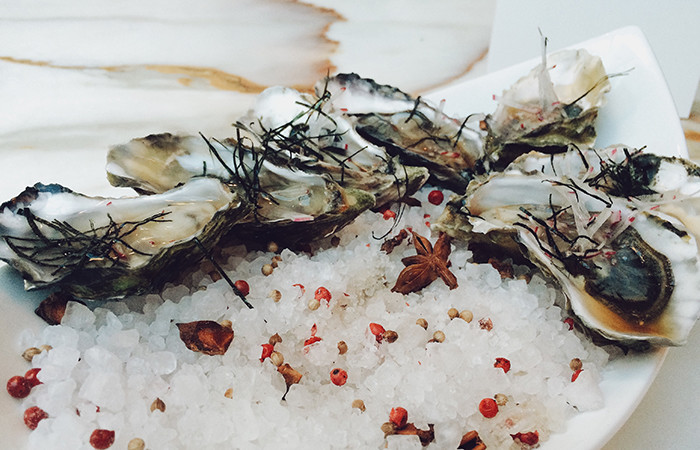Food Security: Eat, Drink and Be Wary
February 23, 2016
4 min read
Everybody eats. Like death and taxes, it’s one of the certainties of life. But with an increasing global population and rapid (geologically speaking) changes to our climate, traditional food sources are no longer a sure thing. Prices are increasing and pressure on our natural environment is becoming more intense every day. These issues will affect you in the future, if they aren’t already. We’ve taken a look at just a few of the issues facing food security now and in the years to come, and made a few recommendations of charities that are working to combat the environmental changes that affect our food supply.
Oysters
 When CO2 dissolves in the ocean, carbonic acid results, causing the overall acidity of the oceans to increase. Unfortunately for shellfish like oysters, lower pH weakens their shells before they can solidify properly, ultimately causing huge losses at shellfish farms and making oysters on the half shell less available and more expensive. Get ready for the average buck-a-shuck to cost quite a few more bucks in the future.
When CO2 dissolves in the ocean, carbonic acid results, causing the overall acidity of the oceans to increase. Unfortunately for shellfish like oysters, lower pH weakens their shells before they can solidify properly, ultimately causing huge losses at shellfish farms and making oysters on the half shell less available and more expensive. Get ready for the average buck-a-shuck to cost quite a few more bucks in the future.
California Produce
 Canadian vegetable consumers are frequently subject to swings in the California agricultural industry. A huge portion of the fruits and vegetables imported to Canada come from the United States. However, with rising global temperatures, weather patterns are becoming unpredictable, culminating most recently in the drought that affected Western North America throughout 2015. When crops fail, prices go up due to limited supply and increased demand. Add to that the recent fall of the Canadian dollar and you’ve got a recipe for a five dollar tomato.
Canadian vegetable consumers are frequently subject to swings in the California agricultural industry. A huge portion of the fruits and vegetables imported to Canada come from the United States. However, with rising global temperatures, weather patterns are becoming unpredictable, culminating most recently in the drought that affected Western North America throughout 2015. When crops fail, prices go up due to limited supply and increased demand. Add to that the recent fall of the Canadian dollar and you’ve got a recipe for a five dollar tomato.
Salmon
 Salmon are a cool water species of fish. Yet humans as a species are doing their very best to raise the temperature of the oceans, impacting the ability of salmon to feed. The salmon that do manage to eat enough to survive to sexual maturity are met with even greater challenges as they proceed to rivers to spawn. Though salmon are excellent upstream swimmers, their fins are too short for pole-vaulting over the industrial dams that block rivers on the way to spawning grounds. While some people are developing technological solutions to these hurdles, others are farming salmon to supply the demanding food industry, which comes with its own set of environmental problems, including sea lice, plankton blooms, and really just a lot of fish poop in one spot.
Salmon are a cool water species of fish. Yet humans as a species are doing their very best to raise the temperature of the oceans, impacting the ability of salmon to feed. The salmon that do manage to eat enough to survive to sexual maturity are met with even greater challenges as they proceed to rivers to spawn. Though salmon are excellent upstream swimmers, their fins are too short for pole-vaulting over the industrial dams that block rivers on the way to spawning grounds. While some people are developing technological solutions to these hurdles, others are farming salmon to supply the demanding food industry, which comes with its own set of environmental problems, including sea lice, plankton blooms, and really just a lot of fish poop in one spot.
Wine
 For most people, wine is not a food group. But it’s still an important part of many meals around the world. Most wine grapes are traditionally grown in Mediterranean climates, characterized by warm, wet winters and hot dry summers. Unfortunately, those same regions are threatened by climate change in a way that could make them unsuitable for wine grapes. It is likely that climate change will move wine industries to other regions but it’s highly unlikely that the French will suddenly pick up and move to Sweden all at once. While the industry transitions, wine could get pricey and Two Buck Chuck could be a thing of the past.
For most people, wine is not a food group. But it’s still an important part of many meals around the world. Most wine grapes are traditionally grown in Mediterranean climates, characterized by warm, wet winters and hot dry summers. Unfortunately, those same regions are threatened by climate change in a way that could make them unsuitable for wine grapes. It is likely that climate change will move wine industries to other regions but it’s highly unlikely that the French will suddenly pick up and move to Sweden all at once. While the industry transitions, wine could get pricey and Two Buck Chuck could be a thing of the past.
What Can You Do?
The easiest way to help is to reduce your consumption. Use less and we’ll have more. You can also buy local to reduce transportation costs, exchange rate woes, and pressure on foreign growing regions. To go a step further, you can give to a highly-rated environmental charity. Organizations like Ecotrust Canada, Oceanwise, and Chefs for Oceans need funding from regular donors to protect habitats, advise restaurants and grocery stores on sustainable practises, and work with governments to adopt new laws that safeguard the environment and our food supply. See our Top Environmental Charities list for more information.
